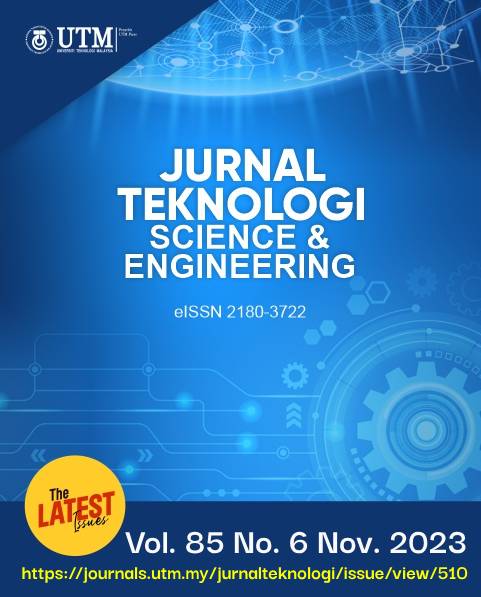PERFORMANCE OF 4253HT SMOOTHER BY DIFFERENT HANNINGS: APPLICATION IN RAINFALL DATA
DOI:
https://doi.org/10.11113/jurnalteknologi.v85.19720Keywords:
Nonlinear smoother, 4253HT, extreme data, rainfall, noiseAbstract
Smoothing is an exploratory data analysis approach that focuses on removing noise or unstructured pattern from data series. This study mainly aims to compare the performance of 4253HT smoother in three types of Hannings and its application in forecasting. A sinusoidal signal was used where five different levels of contaminated normal noise were applied. Overall, 4253HT smoother with Shitan and Vazifean’s Hanning performs excellently over different percentages of noise, good at preserving edges, and able to travel closely with the signal of original pattern. The smoothed rainfall data gives a lower value of RMSE than the raw data which is 12.85 and 24.25 respectively. This concludes that the trend line obtained using smoothed data is more appropriate and reliable for forecasting. These results will be useful in predicting any time series data.
References
Pitas, I. and A. N. Venetsanopoulos. 2013. Nonlinear Digital Filters: Principles and Applications. Springer Science & Business Media.
Pitas, I. and A. N. Venetsanopoulos. 1990. Nonlinear Digital Filters: Principles and Applications. Dordrecht, The Netherlands. Kluwer.
Bovik, A., T. Huang and D. Munson. 1983. A Generalization of Median Filtering using Linear Combinations of Order Statistics. IEEE Transactions on Acoustics, Speech, and Signal Processing. 31(6): 1342-50.
Hird, J. N. and G. J. McDermid. 2009. Noise Reduction of NDVI Time Series: An Empirical Comparison of Selected Techniques. Remote Sensing of Environment. 113(1): 248-58. Doi: https://doi.org/10.1016/j.rse.2008.09.003.
Conradie, W., T. De Wet and M. D. Jankowitz. 2009. Performance of Nonlinear Smoothers in Signal Recovery. Applied Stochastic Models in Business and Industry. 25(4): 425-44. Doi: https://doi.org/10.1002/asmb.774.
Sargent, J. and A. Bedford. 2010. Improving Australian Football League Player Performance Forecasts using Optimized Nonlinear Smoothing. International Journal of Forecasting. 26(3): 489-97. Doi: https://doi.org/10.1016/j.ijforecast.2009.10.003.
Tukey, J. 1977. Exploratory Data Analysis. Addison-Wesley Publishing Company Reading, Mass.
Doi: https://doi.org/10.1002/bimj.4710230408.
Velleman, P. F. and D. C. Hoaglin. 1981. Applications, Basics, and Computing of Exploratory Data Analysis. Duxbury Press.
Rabiner, L., M. Sambur and C. Schmidt. 1975. Applications of a Nonlinear Smoothing Algorithm to Speech Processing. IEEE Transactions on Acoustics, Speech, and Signal Processing. 23(6): 552-7.
Doi: https://doi.org/10.1109/TASSP.1975.1162749.
Martin, R. and S. Schwartz. 1971. Robust Detection of a Known Signal in Nearly Gaussian Noise. IEEE Transactions on Information Theory. 17(1): 50-6.
Masreliez, C. and R. Martin. 1977. Robust Bayesian Estimation for the Linear Model and Robustifying the Kalman Filter. IEEE Transactions on Automatic Control. 22(3): 361-71.
Doi: https://doi.org/10.1109/TAC.1977.1101538.
Azmi, N. N. K., M. B. Adam and N. Ali. 2018. Modified Compound Smoother in Median Algorithm of Span Size 12. 2: 4253HT.
Velleman, P. F. 1975. Robust Nonlinear Data Smoothers: Theory, Definitions, and Applications. Ph. D. Thesis.
Jin, Z. and B. Xu. 2013. A Novel Compound Smoother—RMMEH to Reconstruct MODIS NDVI Time Series. IEEE Geoscience and Remote Sensing Letters. 10(4): 942-6.
Doi: https://doi.org/10.1109/LGRS.2013.2253760.
Shitan, M. and T. Vazifean. 2011. Exploratory Data Analysis for Almost Anyone. UPM Press.
Husain, Q. N. 2017. Modifications of Tukey’s Smoothing Techniques for Extreme Finance Data. Universiti Putra Malaysia.
Muntashir-Al-Arefin and P. M. A. Al. 2015. Package ‘sleekts’. 4253H, Twice Smoothing. Compute Time series Resistant Smooth 4253H, Twice Smoothing Method.
Velleman, P. F. 1980. Definition and Comparison of Robust Nonlinear Data Smoothing Algorithms. Journal of the American Statistical Association. 75(371): 609-15.
Doi: https://doi.org/10.2307/2287657
Jankowitz, M. D. 2007. Some Statistical Aspects of LULU Smoother. South Africa. Stellenbosch University.
Coles, S. 2001. An Introduction to Statistical Modeling of Extreme Values. Springer.
Doi: http://dx.doi.org/10.1007/978-1-4471-3675-0.
Koehler, A. B., Snyder, R. D., and Ord, J. K. 2001. Forecasting Models and Prediction Intervals for the Multiplicative Holt-Winters Method. International Journal Forecast. 17(2): 269-286.
Downloads
Published
Issue
Section
License
Copyright of articles that appear in Jurnal Teknologi belongs exclusively to Penerbit Universiti Teknologi Malaysia (Penerbit UTM Press). This copyright covers the rights to reproduce the article, including reprints, electronic reproductions, or any other reproductions of similar nature.
















